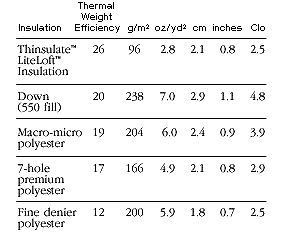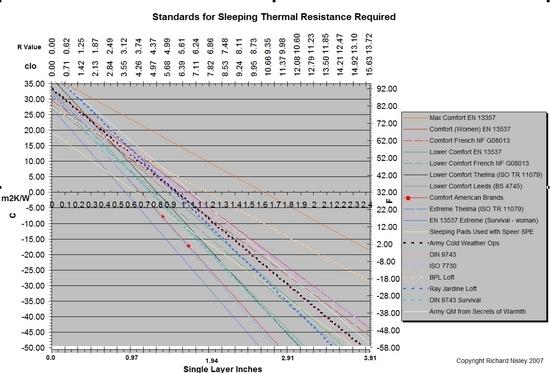Topic
sleeping pad R-values vs temperature ratings
Forum Posting
A Membership is required to post in the forums. Login or become a member to post in the member forums!
Home › Forums › Gear Forums › Gear (General) › sleeping pad R-values vs temperature ratings
- This topic is empty.
-
AuthorPosts
-
Oct 25, 2007 at 3:31 pm #1225567
Suppose I want a top bag and pad for 30 degrees and I try to calculate what is needed. (I'm assuming an average BMR to keep it simple here.)
Using the Backpacking Light Position Statement on Sleeping Bag Temperature Ratings, I get a loft of 1.8". This is within the ranges listed on Mark Verber's webpages and seems reasonable.
Using a table from 3M's Thinsulate webpages:

I calculate that 1.8" of down has an R-value of 6.9.Using a graph posted by Richard Nisley:

I calculate that 1.8" of loft has an R-value of 6.4.These two calculations are fairly close, so it would seem that you need a pad with about R-6.4 to R-6.9 for 30 degrees.
However, this does not agree with what people need in practice. Big Agnes (which makes top bags and pads) lists R-6.5 pads as good for -25 degrees. They also list R-4.1 pads for 15 degrees and R-1.0 pads for 35 degrees. This usage seems to agree with what I've read people are using in the real world.
Why is there such a big gap between theory (R-6.4 to R-6.9) and practice (R-1.0 to R-4.1)? What am I missing?
Oct 25, 2007 at 9:42 pm #1406700I'm just guessing but I think for many conditions the air temperature drops quicker than the ground temperature, thus the smaller temperature differential between your body and the ground requires less insulation resistance to heat flow. Another factor may be that body heat produced naturally rises so to combat that loss the top insulation has to be thicker or more resistant to heat flow. So if you roll over in a top bag attached to a thin pad, your back will likely get cold once the pad is exposed to air. And the bag insulation under you will crush and not resist conduction of heat to the ground.
Oct 26, 2007 at 9:07 pm #1406803I agree.
Soil temperatures would drop at a lower rate than air temps.
However, I still reckon you are better off having more ground insulation (R) than what is "normal". I think it would help. There are times when I wake up in the morning on a sub freezing night and touch my mat outside my sleeping bag and it its quite cold to the touch, even below where my sleeping bag was all night. And I didnt feel the cold during the night…
So a bit more ground insulation (which in terms of R for weight is pretty good value if you are dealing in closed cell foam) might pack alot of punch.Oct 26, 2007 at 11:57 pm #1406811I found another post by Richard Nisley that might explain the discrepancy. He says that if you sleep on your back, about 35% of your warmth is determined from the bottom insulation. If you sleep on your side, about 18%. If you sleep on your stomach, about 50%.
If I take this into account and calculate for sleeping on your back, then you would need a pad with about R-3.4 to R-3.7 for 30 degrees. This does seem to agree with real world usage.
Richard, do these numbers look right to you? Can you tell me where the percentages came from? I like to look at the sources to understand what's going on.
Oct 27, 2007 at 6:01 am #1406820Looking at those percentages makes me that that for the pad heat loss through conduction is more the mechanism, thus contact Area makes a big difference where the heat goes if there are different R values above and below you. Any part of you body not in contact with the ground would be loosing heat to convection, which the bag insulation is supposed to retard (insulation breaks the air space into volumes too small for convection currents to be generated). The general heat transfer equation is heat transfer Rate = Area X Resistance X temperarture Differential between the warm and cold objects. A well fed person who can generate heat at a higher Rate can stand a higher loss Rate and still feel comfortable.
I don't know if R values are a combined term for both conduction and convection, but if they are then you can estimate what would be a good match top R and bottom R values in equivalent heat loss rates by assuming a temp differential for each. Air temp to body difference is easy, estimating ground temperature isn't obvious.
As to Richard's percentages I'm thinking someone on their back would have their arms somewhat folded over their belly or chest, and someone on their stomach would have their arms in full contact with the pad, making it 50%. It makes sense that side sleepers hace much less contact area.
In real world use the ground might be at 45-50 F when the air is at 30 F, so an R value less than 3 might be OK, but padding comfort might start to drive the decision more than warmth.
-
AuthorPosts
- You must be logged in to reply to this topic.
Forum Posting
A Membership is required to post in the forums. Login or become a member to post in the member forums!
Our Community Posts are Moderated
Backpacking Light community posts are moderated and here to foster helpful and positive discussions about lightweight backpacking. Please be mindful of our values and boundaries and review our Community Guidelines prior to posting.
Get the Newsletter
Gear Research & Discovery Tools
- Browse our curated Gear Shop
- See the latest Gear Deals and Sales
- Our Recommendations
- Search for Gear on Sale with the Gear Finder
- Used Gear Swap
- Member Gear Reviews and BPL Gear Review Articles
- Browse by Gear Type or Brand.




